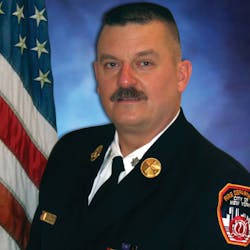At a recent evening drill at a fire department that’s located in Orange County, NY, several young officers conducted a training evolution with a group of firefighters. They went through the steps that were required to transport victims out of burning buildings. Each of the members performed each of the several methods wearing full gear and SCBA. Many departments teach search and rescue and spend most of their time on the search component of the process. This drill concentrated solely on the “rescue,” or removal, element of the tactic.
As the drill wound down and the firefighters stowed their gear, the engine lieutenant announced to the group that it was time for “tool talk.” Without any further instruction, each of the dozen firefighters went to one of the apparatus and came back with a piece of equipment or a tool. Some of the tools were fairly basic, such as a hydrant wrench, and others were more complex, including a thermal imaging camera and a portable radio. As each of the members arrived back on the apparatus floor, they formed up into a large circle, facing the center, where the officer stood.
Randomly, the officer selected one of the firefighters and asked, “What have you got, and how is it used?” The firefighter quickly answered that he had a smooth bore nozzle off of the engine and that it’s used to extinguish fires. Another firefighter asked, “What size hose is that nozzle for?” The first firefighter answered, “1¾-inch pre-connect.” Another firefighter asked, “Is there a single water pattern, or is the nozzle adjustable?” The first firefighter answered that it had a single smooth bore pattern, but a broken stream could be produced by partially closing the nozzle’s control handle.
This question-and-answer period went on for several minutes until the officer ended it and started another one by calling on the next firefighter with another tool.
This process went on for quite a while. A dozen firefighters each held a different piece of equipment or tool, described the equipment or tool and answered questions from the officer and the other 11 members.
Think of the learning opportunity that’s produced from this simple training drill, including the fact that at this volunteer department the drill is repeated every week after a main drill is completed. That means that each firefighter selects a different piece of equipment or tool each week. Do the math and you can see that a whole lot of equipment is discussed and a whole lot of questions about that equipment is asked.
Small crew or large
The officer at the department that’s discussed here records the name of the firefighter and tool that’s selected by each member to keep track of the various tools and equipment that are being examined and discussed and to ensure that the same equipment isn’t discussed week after week.
Now, take this idea and use it at a career fire company where the crew changes every 24 hours. The officers can follow the same routine and gather all of the on-duty members on the apparatus floor and go through the same process. Obviously, a small crew of, say, three or four firefighters can modify this, and the officer also can join in and describe a tool or piece of equipment. Double companies can gather a larger group or even conduct a multi-unit drill with two or three units at one location.
The training benefits that are produced by this process are many. Firefighters get to describe a tool and, maybe, even show off a little with something that they know well. Firefighters get to ask a question about the equipment. The question might be a bit of a test, or it might be something the questioning firefighter doesn’t know. As time goes on, the group as a whole starts to get very familiar with every tool and piece of equipment that’s on their unit’s apparatus.
Let’s get the whole crew together. It’s time for tool talk!
John J. Salka, Jr., will present “Fireground Responsibility” and “RIT Gone Wrong” at Firehouse Expo. To register, visit firehouseexpo.com.
About the Author
John J. Salka Jr.
Battalion Chief
JOHN J. SALKA JR., who is a Firehouse contributing editor, retired as a battalion chief with FDNY, serving as commander of the 18th battalion in the Bronx. Salka has instructed at several FDNY training programs, including the department’s Probationary Firefighters School, Captains Management Program and Battalion Chiefs Command Course. He conducts training programs at national and local conferences and has been recognized for his firefighter survival course, “Get Out Alive.” Salka co-authored the FDNY Engine Company Operations manual and wrote the book "First In, Last Out–Leadership Lessons From the New York Fire Department." He also operates Fire Command Training, which is a New York-based fire service training and consulting firm.

